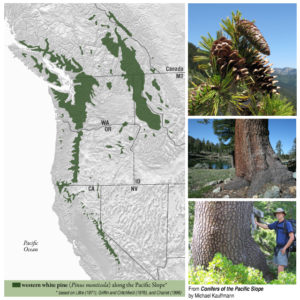Western white pine
Pinus monticola
Tree: to 180′ and 8′ DBH; conic crown becoming broad and flattened
Bark: thin and smooth in younger trees, becoming dark gray to brown, broken into rectangular checkerboard-like pattern (sometimes circular) with deep furrowing
Needles: 2’’-4’’, 5 per fascicle, bluish-green, underside with faint line down midrib; lacks distinct stomatal bloom found in sugar pines
Seed Cones: 5’’-8’’, cylindrical, recurved; dark on inner surface of scale, light brown near tip; on tree year round
Habitat: sea level-9000’, gentle, moist slopes, oceanside in north moving upslope and inland southward, associating with many different conifers across range
Observations: easily found in eastern Sierra Nevada at appropriate elevations, also interior mountains of Washington and Oregon, common above 5,500′ in Klamath Mtns.
Remarks: high mortality across West due to white pine blister rust, bark beetles, and dwarf mistletoe (Arceuthobium monticola)
Information from Conifers of the Pacific Slope by Michael Kauffmann.


